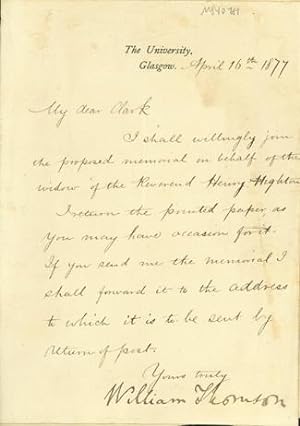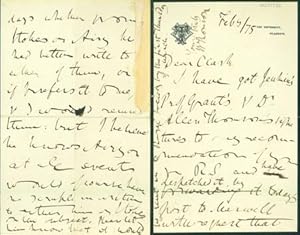thomson william first baron kelvin (2 Ergebnisse)
Produktart
- Alle Produktarten
- Bücher (2)
- Magazine & Zeitschriften
- Comics
- Noten
- Kunst, Grafik & Poster
- Fotografien
- Karten
-
Manuskripte &
Papierantiquitäten
Zustand
- Alle
- Neu
- Antiquarisch/Gebraucht
Einband
- alle Einbände
- Hardcover
- Softcover (1)
Weitere Eigenschaften
- Erstausgabe
- Signiert
- Schutzumschlag
- Angebotsfoto
Land des Verkäufers
Verkäuferbewertung
-
Letter signed to Latimer Clark
Erscheinungsdatum: 1877
Anbieter: Jeremy Norman's historyofscience, Novato, CA, USA
Signiert
Zustand: Very Good. Thomson, William, first Baron Kelvin. Letter signed to Latimer Clark. Glasgow, April 16, 1877. 1 page. 180 x 121 mm. Remains of mounting present. Provenance: Latimer Clark. From the Scottish physicist William Thomson (later Lord Kelvin) to Latimer Clark, an electrical engineer specializing in telegraphic systems. Clark made a number of important investigations in electrical science, leading to his proof that the speed of a current pulse is independent of the voltage applied, and to his demonstration, later expanded upon by Faraday, that the retardation effect in telegraphic cables is due to induction. Thomson was also interested in telegraphy, particulary submarine telegraphy, and became involved in Cyrus Field's Atlantic cable enterprise in late 1856 or early 1857, when he was named to the board of directors of the Atlantic Telegraph Company. Thomson, who "saw telegraphy as an integral part of mathematical physics" (Smith and Wise 1989, 666), took a scientific approach to the design and construction of long-distance submarine cables and signaling equipment, applying theoretical principles he had learned through his studies of electrical phenomena. Thomson's letter to Clark discusses a proposed memorial for the widow of the Reverend Henry Highton. Origins of Cyberspace 206. .
-
Autograph letter signed to Latimer Clark
Erscheinungsdatum: 1875
Anbieter: Jeremy Norman's historyofscience, Novato, CA, USA
Signiert
Zustand: Very Good. Thomson, William, first Baron Kelvin (1824-1906). Atuograph letter signed to Latimer Clark. Glasgow, February 5, 1875. 4pp. 177 x 112 mm. Traces of mounting present. Provenance: Latimer Clark. The Scottish physicist William Thomson (later Lord Kelvin) became involved in Cyrus Field's Atlantic cable enterprise in late 1856 or early 1857, when he was named to the board of directors of the Atlantic Telegraph Company. Thomson, who "saw telegraphy as an integral part of mathematical physics" (Smith and Wise 1989, 666), took a scientific approach to the design and construction of long-distance submarine cables and signaling equipment, applying theoretical principles he had learned through his studies of electrical phenomena. Thomson's recommendations were opposed by the Atlantic Telegraph Company's supervising electrician, E. O. Wildman Whitehouse, a self-taught engineer whom Field had put in charge of designing and manufacturing the cable. Whitehouse had little use for theory, which he believed had no place in the practical world of commercial enterprise; however, his disdain for theoretical knowledge proved disastrous, for his designs were fundamentally unsound, and the first complete Atlantic cable, laid in 1858, failed only weeks after it had been installed. The superiority of Thomson's scientific approach to submarine telegraphy was brought out in a subsequent government investigation, and later undersea cables were constructed to Thomson's recommendations. Thomson's letter to Clark is concerned with his attempt to get Clark into the Royal Society, for which he had solicited the support of no fewer than seven Royal Society members including British engineer Fleeming Jenkin (1833-85), who served with Thomson and Clark on the important Committee on Standards of Electrical Resistance of the British Association for the Advancement of Science; Allen Thomson (1809-84), "the first of the great biological teachers of the nineteenth century" (DNB); Scottish astronomer Robert Grant (1814-92); Astronomer Royal George Biddell Airy (1801-92), with whom Clark had worked to develop a country-wide telegraphic system for reporting Greenwich Mean Time; electrical engineer Charles Walker (1812-82), sender of the first submarine telegraph message; and Thomson's close friend George Gabriel Stokes (1819-1903), Lucasian professor of physics at Cambridge, whose discovery of the nature of fluorescence had important ramifications for spectroscopy. Also mentioned as helping in this project is James Clerk Maxwell (1831-79). Thomson's attempt apparently failed, as Clark was not elected to the Royal Society until 1889. Origins of Cyberspace 205. .



